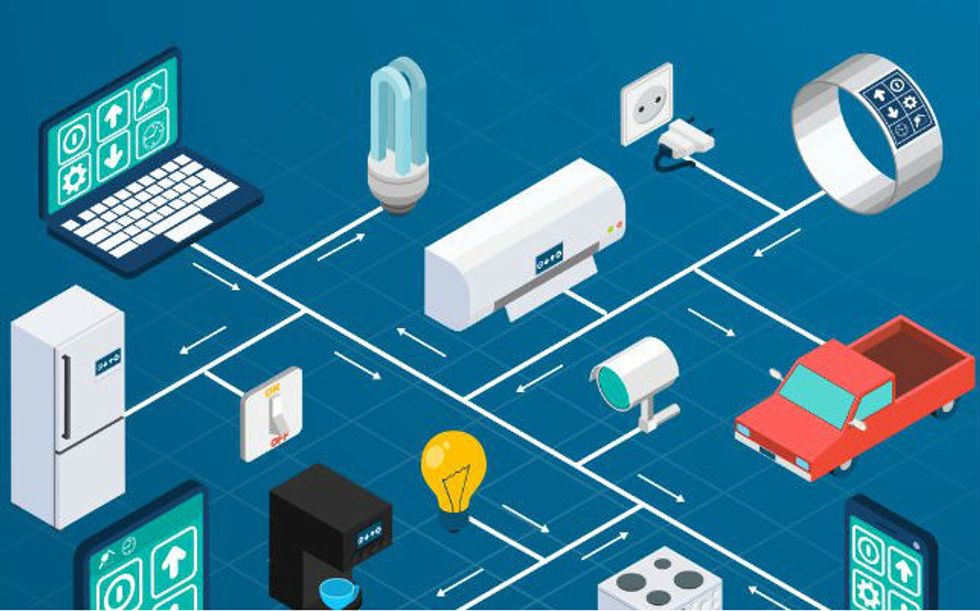The Internet of Things is obviously on the rise: according to IDC, the IoT market is expected to increase spendings up to $1,2 trillion by 2022. Knowing that funding and acquisitions of AI-enabled IoT startups are growing fast, the technology is expected to keep its growth just as fast to meet constantly changing requirements.
As time goes along there will be more info to gather for IoT-enabled devices, so there will be more stuff for them to process. Dealing with huge volumes of data can be made efficient with the help of Artificial Intelligence. Let's review the direction the IoT development companies are moving: let's talk implementing AI into the Internet of Things.
What are the benefits of merging AI and IoT?
The benefit is all about the increased efficiency of processing data. With implementation of Artificial Intelligence the data gets gathered and processed much faster which allows IoT devices perform at the top level. Some AI technologies, like Machine Learning, can make use of all kinds of information, such as temperature, pressure, humidity, location, vibration and sound, then predict and learn different patterns and anomalies of the data. This will allow the devices to change their behavior accordingly.
Examples of combining AI and IoT
We can divide the ways of combining Artificial Intelligence and IoT into five major fields: smart devices, home automation systems, smart vehicles, industry and public safety.
- Smart devices
So we have iRobot with their product Roomba — a company responsible for setting the standard for automated vacuum cleaners capable of moving around the house and cleaning on their own. As the company kept on improving their technology and made good use of AI, the robots started to learn and remember the location of furniture around the house and room layout, adapt to different surfaces of the floor and clean the room with most efficiency. In the future we can also see IoT software development companies making refrigerators learn to identify the food going bad and notify the user. - Smart home systems
Usually smart home can be controlled through the app or physical control panel: all sorts of schedules and preferences can be changed there. With Artificial Intelligence at hand, sensors and smart home devices can learn the habits of the user and the whole system adjusts to those habits. For instance, the smart home can learn the working schedule of the user and lower the temperature during working hours, then crank up the heat to get the house warmer just before the user arrives. This feature alone can do a lot for energy saving purposes. - Smart vehicles
Machine Learning can help self-driving cars predict the behavior of other cars and even pedestrians on the streets in order to avoid accidents and crashes. We can all agree that this is a big deal for a car that doesn't have a driver in it.
As far as commercial vehicles go, fleet management also given some perks from AI implementation. Whatever vehicles there are: ships, plains, trucks or cars, Artificial Intelligence provides the opportunity to identify the most efficient routes and cut back on vehicles downtime. - Industry
The ways of dealing with large amounts of data that AI offers will definitely prove to be beneficial for company trying to, increase the production efficiency, as well as avoid financial losses caused by downtime or cyber threats.
Let's take predictive maintenance as an example. Since different factories are on a different stages of maturity, they have their own ways of organizing maintenance. Ones run scheduled maintenance checks according to recommendations of the equipment original manufacturer. Others make good use of analytics-based Artificial Intelligence software which individually tracks the performance of each piece of equipment. The software provides precise analytics and insights which can help increase equipment's uptime and therefore — profitability of the factory. Sometime those insights may seem counterintuitive and thus be overlooked by human: the need to clean ship's hulls more often actually proved to be more profitable for shipping fleet, despite the cleaning process being expensive and time-consuming. - Public safety
The technology provided by IoT software development companies can be found quite useful when combined with modern surveillance systems capable of recording both video and audio. Advanced voice and face recognition algorithms along with other visual patterns can help optimizing the response time of emergency services and even prevent emergencies from happening at all. Advanced technology can help determine the areas of the city where crime is most likely to happen, identify suspicious behavior of the residents or wanted criminals and notify the corresponding services.
When it comes to law enforcement agencies and services, Machine Learning will be able to optimize data processing, generate insights and patterns that could be missed by human every now and then, therefore enhancing crime-solving.
Think smarter
Combination of Artificial Intelligence and the Internet of Things uncovers new opportunities and capabilities for a variety of business spheres, prolong their growth and ensure prosperity. As the technology moves forward, we succeed in advancing smart homes and devices, vehicles and whole industries with cutting-edge AI technology, pushing our limits further than ever imagined. The limit is set to almost nonexistent here.













